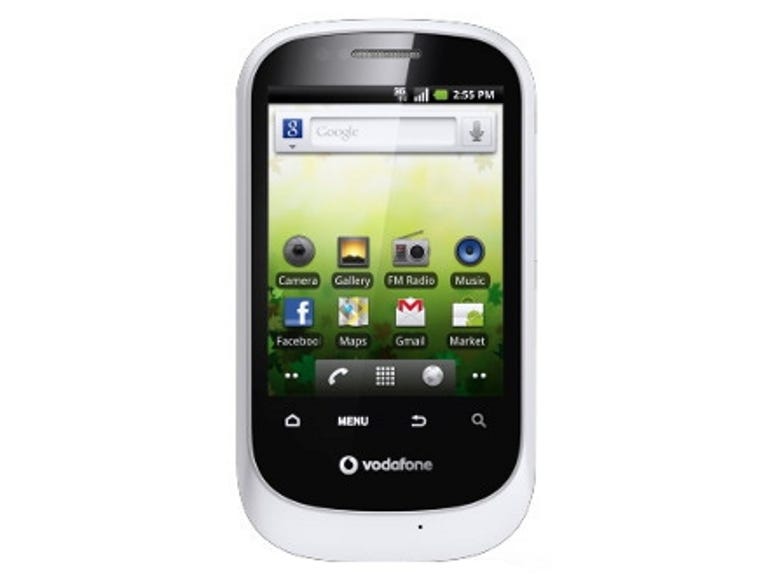 Why You Can Trust CNET
Why You Can Trust CNET Vodafone Smart review: Vodafone Smart
The Vodafone Smart is a ludicrously cheap Android smart phone. When you consider that it retails for almost a tenth of the price of some top-range Android devices, it's easy to forgive its shortcomings.
The war at the budget end of the Android market is rapidly intensifying, and the remarkably cheap Smart represents Vodafone's latest salvo. This pay as you go smart phone boasts a capacitive screen, bespoke battery-cover designs and a solid construction. It offers a great way to join Google's mobile revolution on a shoestring, provided you can live with a few compromises.
The Good
The Bad
The Bottom Line
The Smart costs £60 on a pay as you go deal. It's exclusive to Vodafone.
Bespoke budget brilliance
Despite its humble price tag, you can't accuse the Smart, made by Taiwanese manufacturer Huawei, of feeling cheap or nasty. The phone's dinky frame may lack flair, but it has a thoroughly reassuring weight and solidity to it, making rival budget blowers seem rather lightweight in comparison.

One of the most unique aspects of the Smart is the fact that you can personalise the back plate with your own design. Using Vodafone's online design package, it's possible to cook up a bespoke creation with very little effort. The procedure costs a very reasonable £10.
Another area where the Smart scores points over the competition is the welcome inclusion of a capacitive touchscreen. Many low-end Android phones, including the T-Mobile Pulse Mini and Acer beTouch E210, are saddled with frustrating, pressure-sensitive resistive displays.
The only fly in the ointment is that the touchscreen doesn't support multi-touch gestures, so pinch-to-zoom commands in applications such as Google Maps and your Web browser are out of the question. Boo.
Like the Google Nexus S, the Smart doesn't have any physical buttons on its front. You have the traditional bank of Android-specific commands, but they're touch-sensitive rather than keys you press. The only physical buttons on the phone are the power switch and the volume rocker.
There's no dedicated camera key, but that's not too much of an issue, because the dreary 2-megapixel snapper on the back of the Smart isn't going to win any awards for picture quality. Images are dull and washed-out, with plenty of noise in low-light situations.
There's no LED flash, so shooting in anything but broad daylight is only going to produce photos you'll loathe. Video recording is supported but the clips are acceptable for multimedia messaging and emailing only.
Froyo for you
The Smart runs on Android 2.2 Froyo. Although it's not the latest iteration of Google's mobile operating system, it can still run the vast majority of applications available in the rapidly expanding Android Market.
The rather awkward screen resolution of 240x320 pixels can make some apps difficult to use, and the lack of Adobe Flash support is worth noting -- the lowly processor inside the phone isn't capable of supporting such extravagance.
The 528MHz processor just isn't up to dealing with demanding tasks in general. If you have several apps running in tandem, you'll definitely notice a sharp drop in the Smart's overall performance.
The Smart runs a pretty standard version of Froyo, and isn't bogged down by unnecessary pre-installed applications. The ones that do come with it are mercifully unobtrusive. In fact, the 'pay as you go manager' app is quite useful, allowing you to keep track of your balance and spot when you next need to invest in a top-up card. A file manager is also loaded as standard. It's a near-essential program that isn't commonplace on many Android handsets.
Commit to memory
Like the vast majority of Android phones, the Smart has a microSD card slot so you can expand its memory. A 2GB card is provided as standard but, if you're planning on storing plenty of music or photos on the phone, you'll want to upgrade to a higher-capacity card.
The Smart supports cards of up to 32GB in size. It's a shame that the slot is located beneath the battery, as you'll have to completely power down the phone to access it.
Android handsets traditionally struggle when it comes to battery stamina, and the Smart is no exception. The inclusion of a 1,200mAh power cell in the phone is another attempt to cut costs, and you can expect to charge the phone at least once a day as a result. It's not a disaster -- sweet baby Jesus knows we've seen enough smart phones that can't last beyond 24 hours without a top-up -- but we'd hoped that such a modest device would be less power-hungry.
Conclusion
When you consider its astonishingly low price, it's easy to forgive the Vodafone Smart's shortcomings, such as its low-res screen, lack of multi-touch support and relatively weedy processor. After all, it's about the same price as many far more basic phones -- for example, the Motorola Gleam and Nokia C2-01. For those shopping on a shoestring, the Smart is an excellent way to get into the wonderful world of Android.
Edited by Charles Kloet


